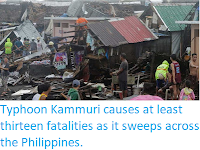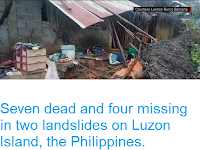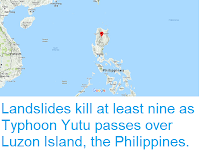Several thousand people have been evacuated from homes around Lake Taal following an eruption on a volcano with the same name on Luzon Island in the Philippines on Sunday 12 January 2020. The eruption produced an ash column about a kilometre high, but vulcanologists are more concerned by the sharp increase in seismic activity beneath the volcano, as such Earthquakes are often
caused by the arrival of fresh magma, which may indicate that a volcano
is about to undergo an eruptive episode.
An ash column above Mount Taal in the Philippines on 12 January 2020. Bullit Marquez/Agence France Presse/Getty Images.
While the volcano is in itself dangerous, much of the concern is that Earthquakes or eruptions around it could trigger a landslide into the lake, triggering a tsunami wave. Tsunamis occur when large volumes of water are displaced by geological
events, such as landslips or Earthquakes, forming waves which spread out
through the surrounding water. Like other waves, tsunamis are not
necessarily obvious in deep, open waters, but when they reach shallow or
enclosed waterways can be extremely dangerous. This is because a
tsunami isn't just a wave above the normal water-level, it is pressure
wave beneath the surface, which is amplified in the enclosed space. A
tsunami reaching the shore is typically
preceded and followed by rapidly shallowing water. Thus people in areas
prone to tsunamis know to evacuate the coast rapidly if the tide
apparently goes out rapidly, since this is likely to be followed by the
tide coming in rapidly. This gives us the English term 'tidal wave'
which is no longer used, since it is inaccurate; the tides are caused by
the gravity of the sun and moon, tsunamis are nothing to do with the
tide. The term 'tsunami' comes from Japan, where earthquakes, and
therefore tsunamis, are common.
How a landslip can trigger a tsunami. University of California, Santa Cruz/BBC.
The
geology of the Philippines is complex, with the majority of the islands
located on the east of the Sunda Plate. To the east of this lies the
Philippine Sea plate, which is being subducted beneath the Sunda Plate
(a breakaway part of the Eurasian Plate); further east, in the Mariana
Islands, the Pacific Plate is being subducted beneath the Philippine Sea
Plate. This is not a smooth process, and the rocks of the tectonic
plates frequently stick together before eventually being broken apart by
the rising pressure, leading to Earthquakes in the process. Material
from the subducting Philippine Plate is heated by the temperature of the
Earth's interior, causing lighter minerals to melt and the resultant
magma to rise through the overlying Sunda Plate, fuelling the volcanoes
of the Philippines.
See also...
Follow Sciency Thoughts on Facebook.









